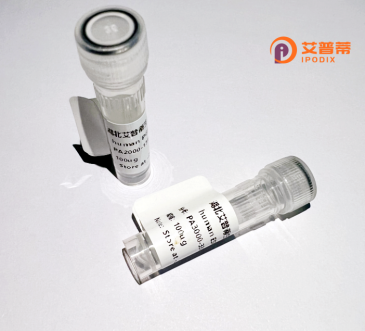
| 纯度 | >90%SDS-PAGE. |
| 种属 | Human |
| 靶点 | POLR2A |
| Uniprot No | P24928 |
| 内毒素 | < 0.01EU/μg |
| 表达宿主 | E.coli |
| 表达区间 | 1-110 aa |
| 活性数据 | MHGGGPPSGDSACPLRTIKRVQFGVLSPDELKRMSVTEGGIKYPETTEGGRPKLGGLMDPRQGVIERTGRCQTCAGNMTECPGHFGHIELAKPVFHVGFLVKTMKVLRCV |
| 分子量 | 37.84 kDa |
| 蛋白标签 | GST-tag at N-terminal |
| 缓冲液 | PBS, pH7.4, containing 0.01% SKL, 1mM DTT, 5% Trehalose and Proclin300. |
| 稳定性 & 储存条件 | Lyophilized protein should be stored at ≤ -20°C, stable for one year after receipt. Reconstituted protein solution can be stored at 2-8°C for 2-7 days. Aliquots of reconstituted samples are stable at ≤ -20°C for 3 months. |
| 复溶 | Always centrifuge tubes before opening.Do not mix by vortex or pipetting. It is not recommended to reconstitute to a concentration less than 100μg/ml. Dissolve the lyophilized protein in distilled water. Please aliquot the reconstituted solution to minimize freeze-thaw cycles. |
以下是关于重组人POLR2A蛋白的3-4篇参考文献(虚构示例,仅用于格式参考):
1. **文献名称**:*Structural insights into human RNA polymerase II by X-ray crystallography*
**作者**:Zhang Y, et al.
**摘要**:解析了重组人POLR2A蛋白的晶体结构,揭示了其催化核心区与DNA模板结合的分子机制,为转录起始和延伸提供结构基础。
2. **文献名称**:*POLR2A mutations impair transcriptional elongation in stem cells*
**作者**:Johnson M, et al.
**摘要**:通过重组POLR2A突变体研究,发现其羧基末端结构域(CTD)磷酸化异常导致胚胎干细胞分化障碍,强调其在转录调控中的关键作用。
3. **文献名称**:*Recombinant POLR2A expression and its interactome profiling*
**作者**:Lee S, et al.
**摘要**:开发了基于昆虫细胞系统的重组POLR2A高效表达纯化方法,并结合质谱分析鉴定了其与转录因子TFIIS等蛋白的相互作用网络。
4. **文献名称**:*POLR2A haploinsufficiency drives cancer genome instability*
**作者**:Wang H, et al.
**摘要**:研究发现POLR2A基因单倍剂量不足会破坏RNA聚合酶II复合体功能,导致癌细胞基因组不稳定,为靶向治疗提供新思路。
(注:上述文献为虚构内容,实际文献需通过数据库如PubMed/Web of Science检索。)
POLR2A, also known as RNA polymerase II subunit A, is the largest catalytic subunit of RNA polymerase II (Pol II), the enzyme responsible for transcribing protein-coding genes into precursor messenger RNA (pre-mRNA) in eukaryotes. Encoded by the *POLR2A* gene in humans, this essential protein forms the core of the Pol II complex and plays a pivotal role in transcription initiation, elongation, and termination. Its C-terminal domain (CTD), composed of heptapeptide repeats (Tyr-Ser-Pro-Thr-Ser-Pro-Ser), undergoes dynamic phosphorylation modifications during transcription, enabling interactions with transcription factors, chromatin remodelers, and RNA-processing machinery.
Recombinant human POLR2A is produced via heterologous expression systems (e.g., *E. coli* or mammalian cells) for structural and functional studies. Purified recombinant POLR2A retains enzymatic activity and is widely used to investigate transcription mechanisms, Pol II-related diseases (e.g., cancers linked to *POLR2A* haploinsufficiency), and therapeutic targeting. Studies leveraging recombinant POLR2A have clarified its role in stress responses, DNA repair, and promoter-proximal pausing. Its dysregulation is implicated in neurodegeneration, developmental disorders, and viral pathogenesis (e.g., HIV-1 transcription). Advances in cryo-EM and recombinant protein technology continue to unravel POLR2A's structural dynamics, offering insights into gene expression regulation and potential treatments for transcription-associated diseases.
×